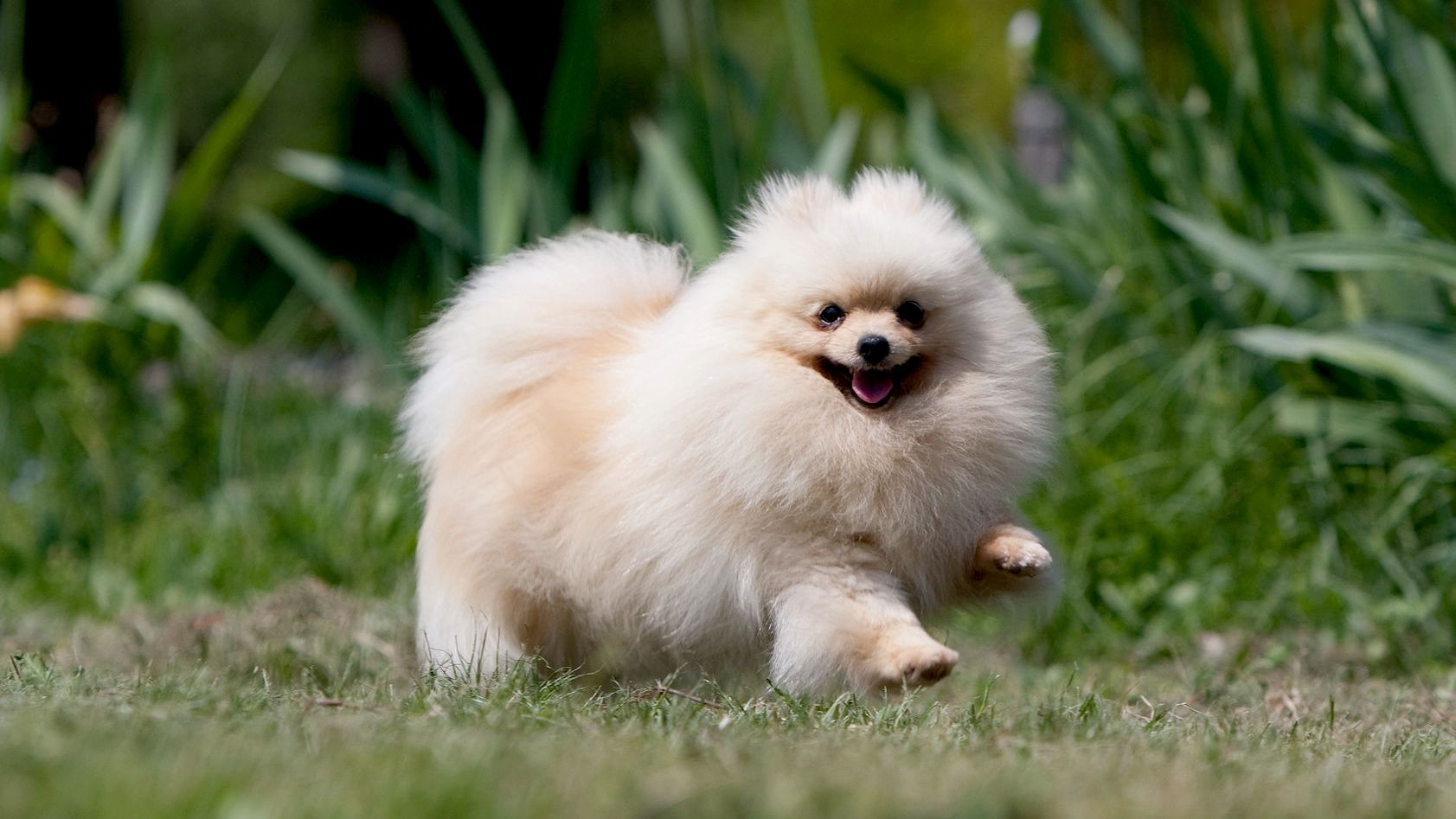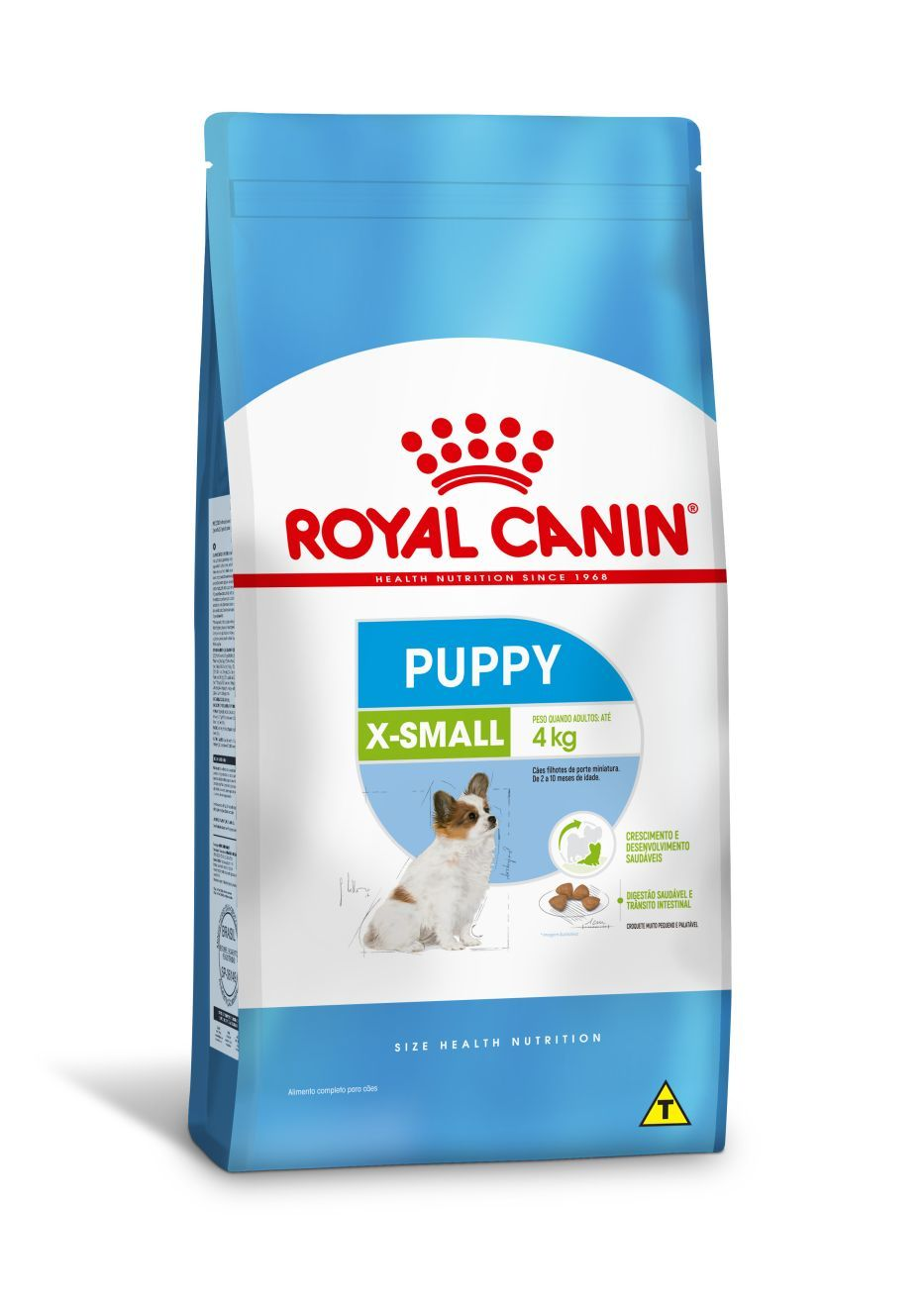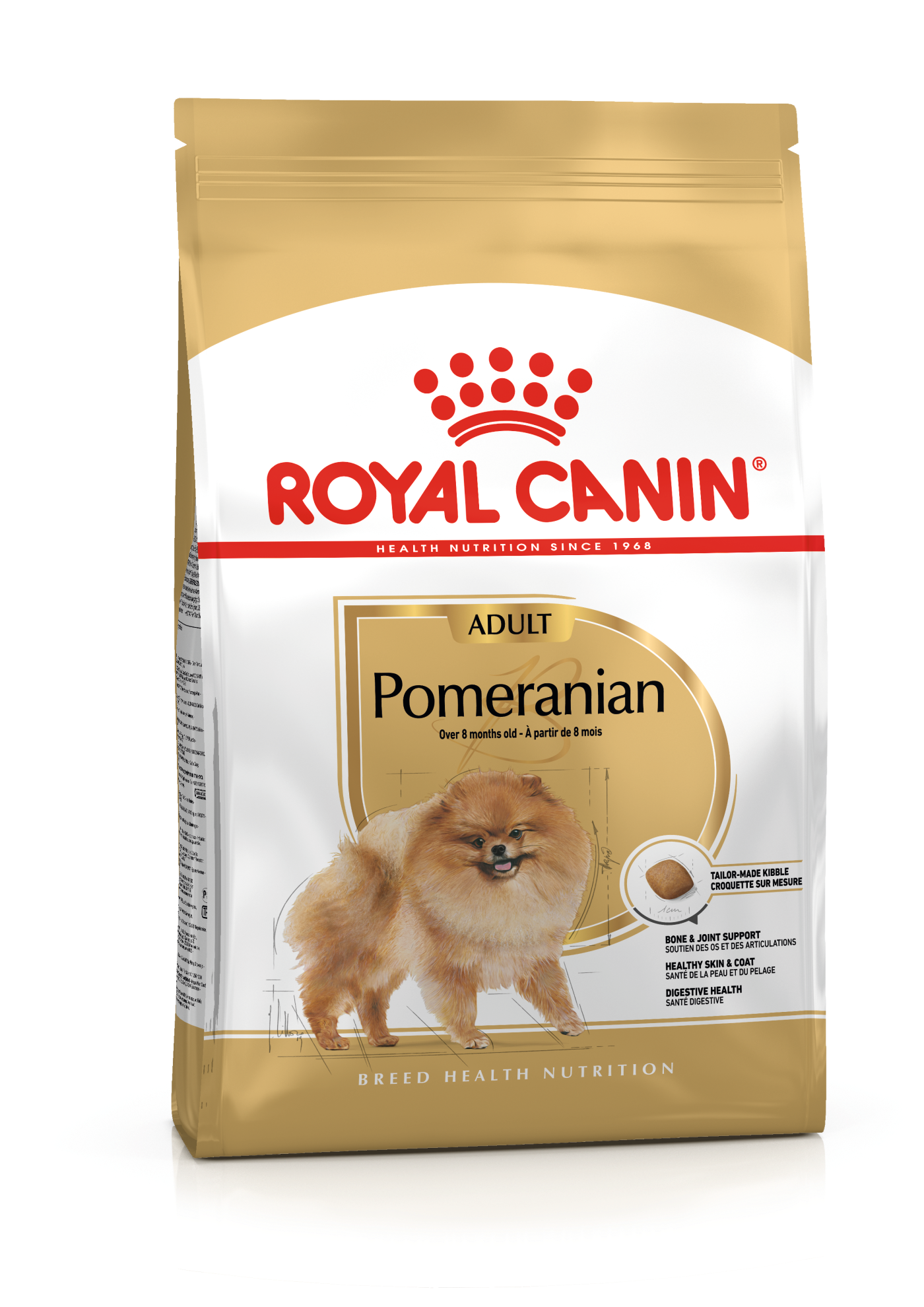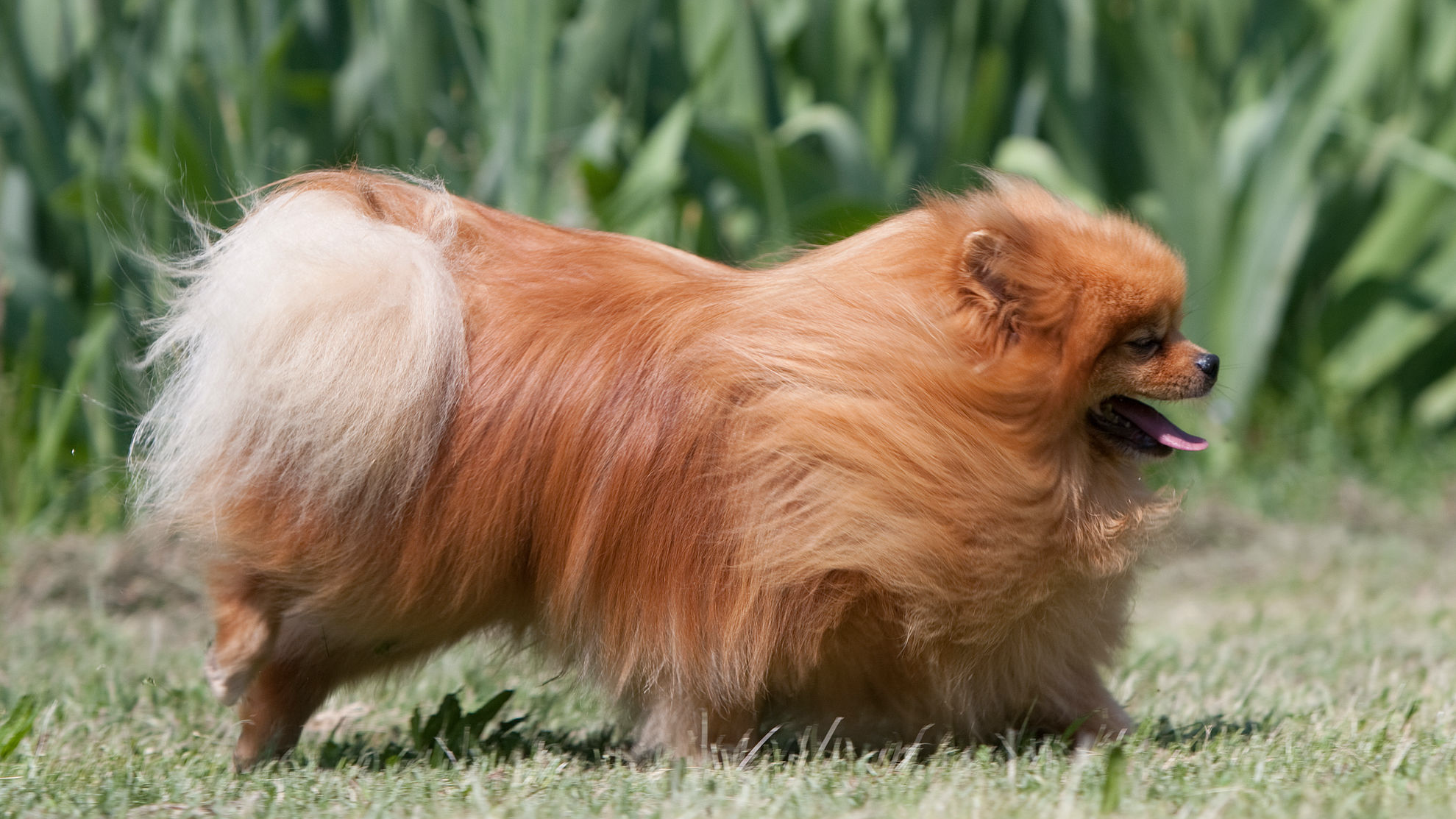Let's talk Pomeranians
Descended originally from sled dogs – albeit much smaller in size today – Pomeranians are smart, playful and full of energy. Known for their foxy faces, ‘smiley’ features and luscious coats – not to mention that distinctive mane-like ‘ruff’ – their bushy tail completes the picture. Always tuned in to approaching strangers, they also make great watch dogs. Big-dog attitude in a small-dog body, really.
Official name: Pomeranian
Other names: Zwergspitz, Toy Spitz, Pom
Origins: Germany
Drooling tendencies
1 out of 5Grooming needs
4 out of 5Shedding Level
4 out of 5Barking tendencies
5 out of 5Energy level
1 out of 5Compatibility with other pets
2 out of 5Warm weather?
2 out of 5Cold weather?
3 out of 5Suited to apartment living
4 out of 5Can stay alone
2 out of 5Family pet
3 out of 5
| Male | Female |
|---|---|
| Height | Height |
| 18 - 30.5 cm | 18 - 30.5 cm |
| Weight | Weight |
| 0 - 3.5 kg | 0 - 3.5 kg |
| Life Stage | |
|---|---|
| Adult | |
| 10 months to 8 years | |
| Mature | Senior |
| 8 to 12 years | 12 to 22 years |
| Baby | |
| Birth to 2 months | |
Drooling tendencies
1 out of 5Grooming needs
4 out of 5Shedding Level
4 out of 5Barking tendencies
5 out of 5Energy level
1 out of 5Compatibility with other pets
2 out of 5Warm weather?
2 out of 5Cold weather?
3 out of 5Suited to apartment living
4 out of 5Can stay alone
2 out of 5Family pet
3 out of 5
| Male | Female |
|---|---|
| Height | Height |
| 18 - 30.5 cm | 18 - 30.5 cm |
| Weight | Weight |
| 0 - 3.5 kg | 0 - 3.5 kg |
| Life Stage | |
|---|---|
| Adult | |
| 10 months to 8 years | |
| Mature | Senior |
| 8 to 12 years | 12 to 22 years |
| Baby | |
| Birth to 2 months | |

Get to know the Pomeranian
All you need to know about the breed
Packing a punch way above their size, Pomeranians may be a whole lot smaller than their sled-pulling ancestors, but they still retain that same mentality. Bold, brash and fearless, they also have an insatiable curiosity for everything around them. They therefore make excellent watchdogs.
On the flipside, Pomeranians can be a bit of a barky breed. So, if you like peace and quiet, or have sensitive neighbours, they may not be the one for you.
That aside, there is so much to love about the Pomeranian personality. Intelligent and attentive, they are always up for interaction with their owners, so are a lot of fun to have around. Also, with a maximum height of just 12 inches (30 cm), the Pomeranian doesn’t need tons of exercise and will adapt well to most home set-ups.
The smallest member of the German Spitz family of dogs, which includes the Samoyed, Alaskan Malamute and Norwegian Elkhound, the Pomeranian is known in some countries as the ‘Toy Spitz’. The breed that we know today was developed in Germany, probably in the 1700s, but was gradually bred to be smaller.
Before long, the Pomeranian had become very in-demand with a host of distinguished fans. Perhaps most notably, Queen Victoria was a huge devotee of the breed and helped to cement their popularity (see more on this part of the Pomeranian’s story in our History of the Breed section).
With a cheeky charm about them, the Pomeranian certainly has a lovely temperament and are a real pleasure to have as a pet. Also, if you’re wondering how long Pomeranians live for, they have an unusually long lifespan, often going strong well into their teens.
No wonder then that the Pomeranian is one of the most popular of the toy breeds. They are also a regular in lists of the top 20 favourite dogs in the world.

Two facts about Pomeranians
1. Stone Age origins
Descended from the German Spitz, the Pomeranian’s lineage goes all the way back to the Stone Age. Excavations in northern Germany unearthed well-preserved specimens that are believed to be the breed’s most ancient ancestors.
2. Back to Titanic
In 1912, two Pomeranians were among only three dogs to survive the sinking of the Titanic. The two lucky animals, along with their owners, were among the survivors fortunate to find themselves on a lifeboat. In the film of the same name, Rose is pictured at the end of the movie holding a Pomeranian.
History of the breed
To go back to their origins, the Nordic ancestors of the Pomeranian were sled dogs in the Arctic. These hardy animals were commonly known as the Wolfspitz or Spitz, and the Pomeranian is descended from the German Spitz.
Named after the historical region of Pomerania (in northern Poland and Germany) where they originated, the Pomeranian breed we know today is thought to have been developed in the 1700s. Originally a much larger dog, the size was reduced through selective breeding and many different coat colours were also introduced.
Within a short space of time, the Pomeranian began gaining popularity – and, before long, they were even in demand with royalty. The first royal we know to have had a Pomeranian was Queen Charlotte – Queen-consort of King George III of Great Britain. Her two Pomeranians were depicted in paintings by Sir Thomas Gainsborough.
Later, Queen Victoria became a huge fan of the Pomeranian too – to the point that she even set up her own breeding kennel. Her influence meant they also had the largest number of entries at Crufts, the UK dog show, for some years.
The inaugural breed club was established in 1891 – at the first ever Crufts event – and the breed standard formulated shortly afterwards. By 1898, the breed had been registered in the US, to the American Kennel Club, and was formally recognized there in 1900. Needless to say, the Pomeranian has been a popular fixture at dog shows – and in the modern home – ever since.
From head to tail
Physical characteristics of Pomeranians
1.Face
2.Body
3.Tail
4.Coat
5.Fur

Things to look out for
From specific breed traits to a general health overview, here are some interesting facts about your Pomeranian
Favour a harness instead of a leash
Like other small-breed dogs, Pomeranians can be susceptible to a progressive condition called ‘tracheal collapse’ – which combines the degeneration of the tracheal cartilage with a weakening of the tracheal membrane leading to a potential narrowing of the airways. Although the condition is inherited, it can be exacerbated by a collar and leash – especially if your Pomeranian lunges forward or the owner pulls back too hard. Symptoms can include a honking noise, coughing, wheezing or trouble breathing, and, in serious cases, they may also faint. For that reason, it’s always best to opt for a harness-style lead. If the condition is severe, surgery can be an option.
Looking after their little legs is important too
Another common problem for the Pomeranian breed is something called patellar luxation. Known as ‘trick knee’ in humans, this is a condition where the kneecap in the hind leg pops out of position. Though it usually goes back into place itself, each time this happens, it damages the lining of the joint. This causes inflammation, and can be quite painful, with symptoms such as limping or an odd ‘skipping’ walk. To keep a check on things, orthopaedic examinations are recommended twice a year, especially as the condition can lead to arthritis in later life. Ensuring your Pomeranian stays at their ideal weight can be a good preventative measure. In more serious cases, pain medication can be prescribed or surgery performed if needed.
Owners will also need to watch out for eye health
One of the other traits to be aware of with Pomeranians is that they can also be prone to some optical issues. These can include cataracts, dry eye and tear-duct problems, among others. As these complaints may affect their sight if left untreated, it’s important to seek professional advice. So, if you spot any symptoms such as redness, scarring or excessive tearing, or if your dog starts rubbing their eyes, contact your veterinarian right away. That way, appropriate steps can be taken in good time. Regular eye checks are also highly recommended.
Healthy diet, healthier dog

When choosing food for a Pomeranian, there are many factors to consider: their age, lifestyle, activity level, physiological condition, and health, including potential sickness or sensitivities. Food provides energy to cover a dog’s vital functions, and a complete nutritional formula should contain an adjusted balance of nutrients to avoid any deficiency or excess in their diet, both of which could have adverse effects on the dog. The following recommendations are for healthy animals. If your dog has health problems, please consult your veterinarian who will prescribe an exclusively veterinary diet. Clean and fresh water should be available at all times to support good urinary regularity. In hot weather and especially when out exercising, bring water along for your dog’s frequent water breaks.
A Pomeranian puppy’s requirements, in terms of energy, protein, minerals and vitamins, are much greater than those of an adult dog. They need energy and nutrients to maintain their body, as well as to grow and build it. Until they are 8 months old, a Pomeranian puppies’ immune system develops gradually. A complex of antioxidants – including vitamin E – can help support their natural defences during this time of big changes, discoveries, and new encounters. Their digestive functions are different from an adult Pomeranian’s, too: their digestive system is not mature yet, so it’s important to provide highly digestible proteins that will be effectively used. A balanced intake of fibres, such as psyllium, can help facilitate intestinal transit and contribute to good stool.
Similarly, a puppy’s teeth — starting with the baby teeth, or first teeth, then the permanent teeth — are an important factor that needs to be taken into account when choosing the size, form and hardness of kibble. This growth phase also means high energy needs, so the food must have a high energy content (expressed in Kcal/100g of food), while concentrations of all other nutrients will also be higher than normal in a specially formulated growth food. It is recommended to split the daily allowance into three meals a day until they are six months old, then to switch to two meals per day.

The main nutritional goals for adult Pomeranians are:
Maintaining an ideal body weight by using highly digestible ingredients and keeping the fat content at a sensible level
Preserving the health and beauty of the skin and coat with the enriched addition of essential fatty acids (especially EPA-DHA), essential amino acids, and B vitamins.
At adult age, very small dogs such as Pomeranians can be prone to constipation so look for a diet formulated with a balanced intake of fibres, including psyllium, to help facilitate intestinal transit, and with highly digestible proteins to contribute to good stool.
The size of the kibble should be very small and adapted to the miniature jaw of Pomeranian in order to avoid problems with picking up food. This may also stimulate their fussy appetite. Very small breed-dogs are prone to urinary stones; a diet that supports a healthy urinary system is recommended.
It is important to avoid feeding Pomeranians human food or fatty snacks. Instead, you can reward them with kibble taken from their daily meal allowance in order to prevent excessive weight gain. It’s also relevant to strictly follow the feeding guidelines written on the package and to do so for sterilised Pomeranians since neutering is a factor in overweight dogs.

After 8 years old, Pomeranians start facing the first signs of ageing. A diet enriched with antioxidants helps maintain vitality, and key nutrients, such as taurine, help support good cardiac function. Ageing is also accompanied by the modification of digestive capacities and particular nutritional requirements, so food for ageing Pomeranians should have the following characteristics:
Higher vitamin C and E content. These nutrients have antioxidant properties, helping to protect the body’s cells against the harmful effects of the oxidative stress linked to ageing.
High-quality protein. Contrary to a widely held misconception, lowering the protein content in food brings little benefit in limiting kidney failure. In addition, older dogs are less efficient at using dietary protein than younger dogs. Reducing the phosphorus content is a good way of slowing down the gradual deterioration of kidney function.
A higher proportion of the trace elements iron, copper, zinc, and manganese to help maintain good condition of the skin and coat.
A higher quantity of polyunsaturated fatty acids to help maintain the quality of the coat. Dogs can normally produce these fatty acids, but ageing can affect this physiological process.
As they age, dogs increasingly suffer from teeth problems. To ensure they continue to eat in sufficient quantities, the shape, size, and hardness of their kibble needs to be tailored to their jaw.

Caring for your Pomeranian
Grooming, training, and exercise tips
Being so tiny, Pomeranians have lower exercise needs than average. However, they still require a daily walk, and ideally two, with the chance to stretch their little legs and sniff around outdoors. Because of the Pomeranian’s small size, dog parks are best avoided as they may inadvertently get knocked over by larger breeds – and they themselves will sometimes challenge bigger animals. When at home in the garden or backyard, it’s important to keep a close eye on them as these miniature Houdinis are also known for escaping – even through small gaps. Pomeranians can be prone to middle-age spread, so keep them active, though they like nothing better than snuggling up in your lap.
That glorious fox-like coat is one of the Pomeranian’s defining features, but you’ll need to give it regular attention to ensure it stays at its best. A light daily brushing will help remove any dead hair and keep it looking shiny. And, as Pomeranians have a double coat – a soft, thick undercoat of dense hair and a longer outer coat – they will benefit from a deeper brushing once a week. A full professional grooming for your Pomeranian, including a bath, is recommended every four to six weeks. As the Pomeranian can shed quite profusely, these regular sessions should help to keep excess hair away from the carpet too. Nails should be kept short, teeth brushed at least weekly (and daily ideally) and ears checked regularly.
As a very smart breed of dog, the Pomeranian will thrive on a tailored training programme that provides both mental and physical stimulation. They will enjoy sharing games with you at home, too. For those that show an aptitude to progress further, they can also do well in disciplines such as agility, obedience and rally – and they make good therapy dogs too. Just a couple of things to bear in mind… The Pomeranian can have a tendency to be a bit ‘vocal’, especially as they are rather suspicious of strangers. Early socialization can help with this. They can also take a little longer than average when it comes to toilet training, so kindness, consistency and all-round general patience are key.
Being so tiny, Pomeranians have lower exercise needs than average. However, they still require a daily walk, and ideally two, with the chance to stretch their little legs and sniff around outdoors. Because of the Pomeranian’s small size, dog parks are best avoided as they may inadvertently get knocked over by larger breeds – and they themselves will sometimes challenge bigger animals. When at home in the garden or backyard, it’s important to keep a close eye on them as these miniature Houdinis are also known for escaping – even through small gaps. Pomeranians can be prone to middle-age spread, so keep them active, though they like nothing better than snuggling up in your lap.
That glorious fox-like coat is one of the Pomeranian’s defining features, but you’ll need to give it regular attention to ensure it stays at its best. A light daily brushing will help remove any dead hair and keep it looking shiny. And, as Pomeranians have a double coat – a soft, thick undercoat of dense hair and a longer outer coat – they will benefit from a deeper brushing once a week. A full professional grooming for your Pomeranian, including a bath, is recommended every four to six weeks. As the Pomeranian can shed quite profusely, these regular sessions should help to keep excess hair away from the carpet too. Nails should be kept short, teeth brushed at least weekly (and daily ideally) and ears checked regularly.
As a very smart breed of dog, the Pomeranian will thrive on a tailored training programme that provides both mental and physical stimulation. They will enjoy sharing games with you at home, too. For those that show an aptitude to progress further, they can also do well in disciplines such as agility, obedience and rally – and they make good therapy dogs too. Just a couple of things to bear in mind… The Pomeranian can have a tendency to be a bit ‘vocal’, especially as they are rather suspicious of strangers. Early socialization can help with this. They can also take a little longer than average when it comes to toilet training, so kindness, consistency and all-round general patience are key.
7/7
All about Pomeranians
No, the Pomeranian is descended from the German Spitz, and although they have many similar characteristics, they are two different breeds. The main difference is the size. By way of comparison, the Pomeranian is usually around half the size of the German Spitz.
Always on high alert, Pomeranians are very sensitive to what’s going on around them and like to tell everyone else about it too. They also tend to be a bit suspicious of strangers and can be quite vocal about that as well. Early socialization, puppy training and using positive reinforcement to teach them the “Quiet” command can all help.
Read More about Breeds
Sources
- Veterinary Centres of America https://vcahospitals.com/
- Royal Canin Dog Encyclopaedia. Ed 2010 and 2020
- Banfield Pet Hospital https://www.banfield.com/
- Royal Canin BHN Product Book
- American Kennel Club https://www.akc.org/
Like & share this page